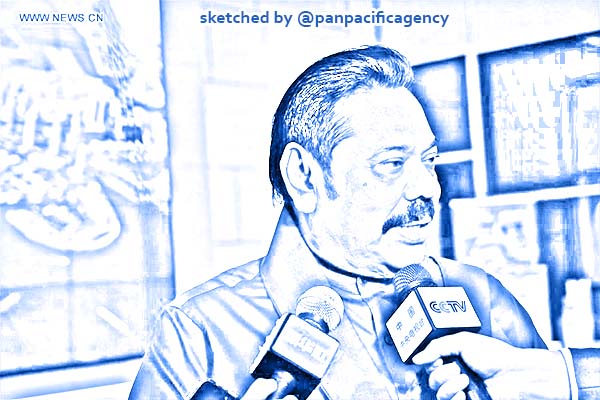[Analytics] Sri Lanka’s struggle to bring down the Rajapaksas

Sri Lanka's new Prime Minister Mahinda Rajapaksa speaks in an interview during his visit to the Colombo Port City in Colombo, Sri Lanka, Dec. 7, 2019. (Xinhua/Tang Lu). Sketched by the Pan Pacific Agency.
When Sri Lankan President Gotabaya Rajapaksa banned chemical fertiliser, insecticides and herbicides in May 2021, protesters blamed the government rather than the President or his brother, former prime minister Mahinda Rajapaksa. But this time, spurred by the island’s worst ever economic crisis, protests have turned against Rajapaksa rule. Neil DeVotta specially for the East Asia Forum.
The original fertiliser ban was dictated by a balance of payments crisis. This crisis was caused by a bloated government service, inefficient state enterprises, a massive security force that was not demobilised after the civil war ended in 2009, loss of crucial revenue from a reduction of various taxes in 2019 and COVID-19’s disruption of remittances and tourism. Non-concessionary Chinese-funded white elephant infrastructure projects have also fuelled this balance of payments crisis and China’s aversion to renegotiating loans may make tackling the crisis harder.
The debts owed total around US$51 billion, with US$7 billion due this year and around US$31 billion due over the next five years. As expected, in early April 2022 the government announced its loans could not be serviced. Soon afterwards, the new Prime Minister claimed the government struggled to locate even US$1 million for essential imports. The country is bankrupt.
Sri Lankans have been forced to queue for petrol, cooking gas, kerosene, sugar, milk powder and medicines, on top of enduring long power cuts. While farmers and unions have expressed outcry for a year, anti-government sentiment took a significant turn when the middle-class began protesting. In March, women from the main opposition party protested outside the President’s residence. The next month, people gathered across the Presidential Secretariat to demand the President leave office. Those who camped there branded the location GotaGoGama and soon after a smaller group gathered outside former prime minister Mahinda Rajapaksa’s residence and branded it MynaGoGama.
On 9 May, Mahinda Rajapaksa and his associates bussed in SLPP (Sri Lanka Podujana Peramuna) supporters who attacked the peaceful protestors, including clergy members, outside the residence and at the nearby GotaGoGama while police merely looked on. Some hours later, protestors and their sympathisers counterattacked Rajapaksa supporters, targeting homes and businesses belonging to pro-Rajapaksa politicians. The Rajapaksa ancestral home was burnt down, and a museum honouring their parents was also destroyed. The mayhem killed nine, including a member of parliament, and the the military was ordered to shoot rioters.
Mahinda Rajapaksa stepped down as Prime Minister the same day his supporters ran amok. Three days later, a magistrate prohibited Mahinda and some loyalists from leaving the country. By then, Mahinda’s two other siblings and a nephew had also resigned as ministers. President Gotabaya Rajapaksa held on despite the protests and a few days later made the United National Party’s (UNP) Ranil Wickremasinghe prime minister.
This would be Wickremasinghe’s sixth stint as prime minister, although he has never completed a full five-year term. While knowledgeable and experienced, he exudes arrogance and omniscience. His superiority complex undermined his relationship with president Chandrika Kumaratunga and Maithripala Sirisena — both removing him as prime minister during their presidential terms. One of Sri Lanka’s biggest ever financial scandals took place under his watch in 2015, which partly led to the UNP’s loss of all 106 seats it held.
Today, Wickremasinghe is the only UNP member in Sri Lanka’s parliament thanks to the National List where parties are awarded seats based on their island-wide vote share. He is especially good friends with Mahinda Rajapaksa, and it was Wickremasinghe who quietly protected the Rajapaksas between 2015 and 2019. Many wonder if his present appointment is part of a deal to once more shield the Rajapaksas from corruption charges. Ultimately, the country’s sorry situation is encapsulated by a President people desperately want gone appointing a Prime Minister who is his party’s sole parliamentary representative.
The political dilemma facing the island is that Gotabaya Rajapaksa can remain President until November 2024, unless parliament impeaches him with a two-thirds majority. Most SLPP parliamentarians, numbering 145 in a house seating 225, will not support impeachment. Parliament can vote to dissolve itself, but the vast majority know they will not be re-elected so legislators have no incentive to take that route. The associated economic dilemma is that creditors will not agree to further loans and debt restructuring without political stability, and political stability is unlikely until the protests cease or the president leaves.
The protestors have achieved much, forcing cabinet members to resign and Mahinda Rajapaksa to leave. In the process, they acquired support from religious, cultural, educational and business elites. Wickremasinghe’s appointment, coupled with the need for political stability, could help the President stay on. If Gotabaya Rajapaksa departs, this is most likely the end of the Rajapaksa dynasty.
But the complete ouster of Rajapaksa rule will not transform Sri Lanka unless the country embraces the rule of law and pluralism. The current intercommunal bonhomie among protestors masks the Sinhalese Buddhist nationalism that helped the Rajapaksas to power. Getting rid of them and their ilk is a necessary but insufficient step towards achieving the widespread systemic change that protestors desire. Real change will only come once the island sheds its majoritarian and ethnocentric ethos. Sadly, the country’s post-independence history suggests this is unlikely.
Neil DeVotta is Professor of Politics and International Affairs at Wake Forest University.